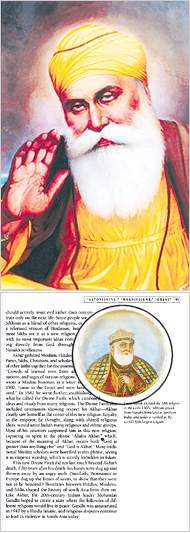
The controversial image isn't the big one pictured, but the small one (I've added a circle to make it clearer). The image is a 19th century painting of Guru Nanak wearing a crown and what looks like a somewhat cropped beard. Both the crown and the beard shape are troubling to Sikhs, who are accustomed to seeing images of Guru Nanak more along the lines of the bigger image to the right -- flowing white beard, and humble attire.
Though the New York Times has good interviews with community members on this, the Contra Costa Times actually spells out the issue more clearly:
The image is taken from a 19th-century painting made after Muslims ruled India. The publisher used it because it complies with the company's policy of using only historical images in historical texts, said Tom Adams, director of curriculum for the Department of Education.
After Sikhs complained that the picture more closely reflected a Muslim man than a Sikh, Oxford offered to substitute it with an 18th-century portrait showing Guru Nanak with a red hat and trimmed beard. But Sikhs said that picture made their founder look like a Hindu.
The publisher now wants to scrap the picture entirely from the textbook, which was approved for use in California classrooms in 2005. There are about 250,000 Sikhs in California.
Sikh leaders say they want a new, more representative image of Guru Nanak, similar to the ones they place in Sikh temples and in their homes. The publisher has rejected those images as historically inaccurate. No images exist from the founder's lifetime, 1469 to 1538. (link)
All of this raises the question -- what, in fact, did Guru Nanak look like? We don't have any images from his lifetime, and the later ones are clearly products of the values of their eras. What, historically, do we actually know? I went to Navtej Sarna's recent book, The Book of Nanak, to see what I could find out.
First off, I would recommend Navtej Sarna's book -- it's part of a series Penguin is doing, that also includes The Book of Mohammed. It's short, but it's well-written and accessible.
Secondly, Sarna states the obvious problem with any historical account of Guru Nanak: we don't have official (as in modernized, chronological) histories to work with, but rather a series of Janamsakhis, some of which were written down shortly after Guru Nanak's lifetime by personal associates, while others were written down a bit later -- at two or three degrees of separation. Some of the relevant manuscripts are mentioned, sketchily, at the Wikipedia site for Janamsakhis. (This Wikipedia entry could be improved!)
Some professional historians simply opt out of saying anything concrete about Guru Nanak's life. J.S. Grewal, for instance, in The Sikhs of the Punjab, goes right into textual analysis of passages from the Adi Granth, and doesn't mention any Janamsakhis. Sarna, for his part, acknowledges that his own work is based on the Janamsakhi materials, and proceeds on the basis that some of what is described is factual, while some must be under the category of folklore, and educated guesses have to be made. Along those lines, he comes up with a surprising description of Guru Nanak's attire:
Nanak was accompanied by Mardana on his travels, who carried his rabab. He dressed in strange clothes that could not be identified with any sect and symbolized the universality of his mesage. He wore the long, loose shirt of a Muslim dervish but in the brownish red colour of the Hindu sanyasi. Around his waist he wore a white kafni or cloth belt like a faqir. A flat, short truban partly covered a Qalandar's cap on his head in the manner of Sufi wanderers. On his feet, he wore wooden sandals, each of a different design and colour. Sometimes, it is said, he wore a necklace of bones around his neck. (53-54)
Unfortunately, Sarna does not tell us which Janamsakhi this derives from -- and I'm sure people would be interested to know, since this is a bit different from the common image of Guru Nanak. Sarna does later mention that at the end of his travels, Guru Nanak gave up these "travel clothes" and adopted the ordinary dress of a "householder."
At every point, however, what's emphasized is the strength of Guru Nanak's personal humility and his rejection of personal wealth or political power (which is not the same as a rejection of the material world). So the crown that's pictured in the first version of the California textbook is certainly incorrect. The rest, however, is probably open to conjecture and argument.
*
One other thought: this controversy is obviously part of a new pattern of textbook contestation in California. An earlier chapter occurred last year, when the Hindu Education Foundation and the Vedic Foundation wrote long reports offering their criticisms and suggestions of the representation of Hinduism in California school textbooks. In a post on the subject, I reviewed the details of those reports, and came to feel that some were good suggestions, while others seemed to be cases of whitewashing history. Though some of the dynamics are similar, this is a very different (and indeed, much simpler) case.